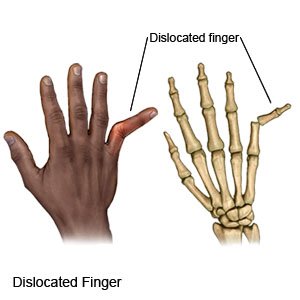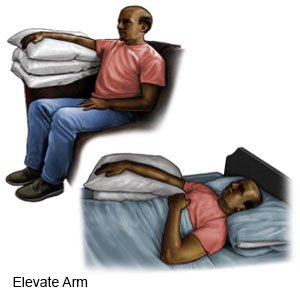Finger Dislocation
Medically reviewed by Drugs.com. Last updated on Apr 6, 2025.
What is a finger dislocation?
A finger dislocation happens when bones in your finger move out of their normal position.
 |
What are the signs and symptoms of a finger dislocation?
- Pain, swelling, numbness, or tingling
- Crooked, bent, or misshapen finger
- Trouble moving, bending, or straightening the finger
- Pale or cool skin over the dislocation
How is a finger dislocation diagnosed?
Your healthcare provider may ask you to move your finger or hand. X-ray, MRI, CT, or ultrasound pictures may show a dislocation or other injury. You may be given contrast liquid to help your finger show up better in the pictures. Tell the healthcare provider if you have ever had an allergic reaction to contrast liquid. Do not enter the MRI room with anything metal. Metal can cause serious injury. Tell the healthcare provider if you have any metal in or on your body.
How is a finger dislocation treated?
- Prescription pain medicine may be given. Ask your healthcare provider how to take this medicine safely. Some prescription pain medicines contain acetaminophen. Do not take other medicines that contain acetaminophen without talking to your healthcare provider. Too much acetaminophen may cause liver damage. Prescription pain medicine may cause constipation. Ask your healthcare provider how to prevent or treat constipation.
- Acetaminophen decreases pain and fever. It is available without a doctor's order. Ask how much to take and how often to take it. Follow directions. Read the labels of all other medicines you are using to see if they also contain acetaminophen, or ask your doctor or pharmacist. Acetaminophen can cause liver damage if not taken correctly.
- NSAIDs , such as ibuprofen, help decrease swelling, pain, and fever. This medicine is available with or without a doctor's order. NSAIDs can cause stomach bleeding or kidney problems in certain people. If you take blood thinner medicine, always ask if NSAIDs are safe for you. Always read the medicine label and follow directions. Do not give these medicines to children younger than 6 months without direction from a healthcare provider.
- A procedure may be used to move your finger bones back into place. This is done by moving your finger and hand in different positions until your bones line up properly. The procedure is sometimes done during surgery.
- Your finger may be buddy-taped, splinted, or put in a cast to hold your finger or thumb in place while it heals. Buddy tape means your injured finger is taped to the finger next to it. A splint is a piece of stiff material attached to your finger using cloth straps. You may have these treatments for 8 weeks or more. Ask for more information about how to care for a splint or cast.
What can I do to manage a finger dislocation?
- Apply ice to your finger. Apply ice for 15 to 20 minutes every hour or as directed. Use an ice pack, or put crushed ice in a plastic bag. Cover it with a towel before you apply it to your finger. Ice helps prevent tissue damage and decreases swelling and pain.
- Elevate your finger above the level of your heart. This can help reduce swelling. Prop your arm or hand on a pillow. This should be done as often as you can for the first 1 to 3 days after your injury.

- Exercise your finger, as directed. Exercise can help reduce pain, swelling, and stiffness in your finger. It also can help increase strength and movement. You may need to exercise your finger as soon as you can. You also may be told not to move your finger for a few weeks. Be sure to follow your healthcare provider's instructions.
When should I seek immediate care?
- You have increased swelling under your splint or cast.
- You think your cast or splint is too tight.
- You cannot move your fingers.
When should I call my doctor?
- You have numbness or tingling in your hand.
- The skin under your cast or splint burns or stings.
- The skin around your cast becomes red or raw.
- Your cast becomes cracked or damaged.
- You have questions or concerns about your condition or care.
Care Agreement
You have the right to help plan your care. Learn about your health condition and how it may be treated. Discuss treatment options with your healthcare providers to decide what care you want to receive. You always have the right to refuse treatment. The above information is an educational aid only. It is not intended as medical advice for individual conditions or treatments. Talk to your doctor, nurse or pharmacist before following any medical regimen to see if it is safe and effective for you.© Copyright Merative 2025 Information is for End User's use only and may not be sold, redistributed or otherwise used for commercial purposes.
Further information
Always consult your healthcare provider to ensure the information displayed on this page applies to your personal circumstances.
